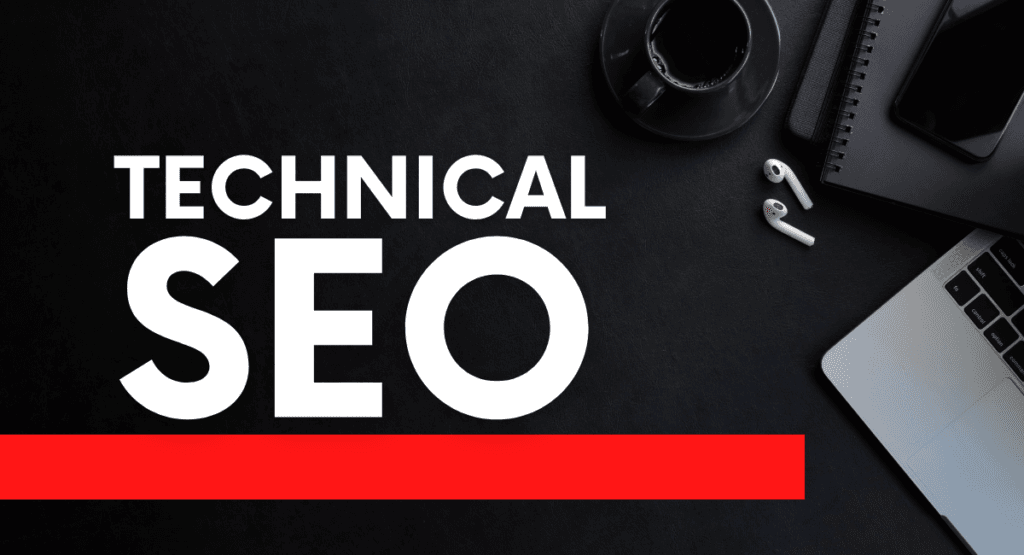Introduction
Brief introduction to SEO (Search Engine Optimization)
Search engine optimisation, or SEO, is the process of making modifications to a website so that it ranks higher in search engines such as Google. SEO improves a website’s rankings, attracts organic traffic, and makes it more relevant to user searches by optimising its content, structure, and technology.
Importance of Technical SEO in overall SEO strategy
Technical SEO is critical for search engines to quickly crawl, index, and understand your website. It discusses subjects including site speed, structured data, mobile friendliness, and secure connections (HTTPS), all of which are critical for boosting a website’s overall performance and search engine results.
What is Technical SEO?
Definition and explanation of Technical SEO
Search engine optimisation, or SEO, is the process of improving a website’s exposure on search engine results pages (SERPs). SEO increases site authority, attracts organic traffic, and promotes conversions by optimising a variety of variables such as content, keywords, and backlinks. This gradually increases the website’s visibility on the internet.
Difference between Technical SEO and other types of SEO (On-page, Off-page)
Technical SEO is required to ensure that a website meets the technical standards of modern search engines. It include improving changes to factors such as site speed, security, mobile friendliness, and crawlability. Every strong SEO strategy must begin with technical SEO since it ensures that a website is efficiently indexed and ranked by search engines, improves user experience, and increases site performance.
Importance of Technical SEO
Impact on website performance and user experience
Technical SEO ensures fast page load times, secure connections, and mobile compatibility, all of which have a direct impact on user experience and website performance. Well-optimized websites provide increased customer satisfaction, lower bounce rates, and visitor retention, all of which increase user engagement and conversion rates.
Role in search engine rankings and visibility
Technical SEO plays a vital role in determining search engine visibility and rankings. Better rankings result from properly optimised websites, which are easier for search engines to crawl and index. HTTPS, structured data, and site speed are all elements that influence search engine algorithms and improve a website’s SERP ranking.
Ensuring search engines can crawl and index a website effectively
Technical SEO ensures that search engines can efficiently crawl and index a website by optimising elements such as robots.txt files, XML sitemaps, and site architecture. As a result, search engines may better understand the website’s content, structure, and relevancy, resulting in proper indexing and increased search exposure.
Key Elements of Technical SEO
Website Speed and Performance
Importance of fast loading times
Fast loading websites increase user experience, lower bounce rates, and rank higher in search results since search engines prefer these types of sites.
Tools to measure and improve website speed
To measure a website’s speed, utilise tools such as Google PageSpeed Insights and GTmetrix, which provide useful recommendations for increasing loading times and overall performance.
Mobile-Friendliness
Importance of responsive design
A responsive website can automatically adjust to different screen sizes and devices, ensuring a consistent user experience. Improving usability and accessibility is essential for keeping users on your website longer and lowering bounce rates, both of which boost search engine rankings.
Google’s mobile-first indexing
Google prioritises mobile versions of websites for indexing and ranking, following their mobile-first indexing policy. Making your website mobile-friendly is critical for maintaining and improving search rankings since it has a direct impact on how Google analyses content.
Tools to test mobile usability (e.g., Google Mobile-Friendly Test)
These tools assess a website’s mobile friendliness by looking at features including touch element spacing, font size, and viewport settings. These tools provide insights and recommendations for boosting mobile performance, which is a critical component of effective SEO.
Crawlability and Indexability
What are crawling and indexing?
Crawling is used by search engines to browse through a website’s content; indexing, on the other hand, is the process of organising and storing this content for presentation in search results. Both processes have an impact on a webpage’s exposure and search engine rankings.
Creating and optimizing XML sitemaps
XML sitemaps list a website’s main pages to help search engines understand its structure and find new content. When sitemaps are updated and optimised on a regular basis, they boost search visibility and ensure that all relevant pages are indexed.
Importance of robots.txt file
The robots.txt file is necessary because it instructs search engine bots which pages to crawl and which to ignore. If this file is configured appropriately, duplicate or sensitive material will not be indexed, hence boosting its effectiveness.
Handling crawl errors and fixing broken links
Broken links and crawl issues degrade user experience and complicate search engine indexing. Regular monitoring and rectification of these issues can help to guarantee that all pages are accessible while also improving the website’s overall health and SEO performance.
URL Structure
Importance of clean and descriptive URLs
The significance of descriptive and simple-to-read URLs: Clear and descriptive URLs are simple to read and comprehend for both people and search engines. They help enhance SEO by increasing click-through rates, improving user experience, and providing clear context for page content.
Best practices for URL optimization
They should be concise, contain relevant keywords, and use hyphens to separate words. When dynamic parameters and special characters are removed from URLs, they are guaranteed to be more user-friendly and more likely to be correctly indexed by search engines.
Using canonical tags to avoid duplicate content issues
Canonical tags identify a page’s preferred version, hence preventing duplicate content concerns. They help to consolidate link equity and ensure that search engines index the proper page, hence maintaining the website’s SEO integrity.
HTTPS and Website Security
Importance of SSL certificates
SSL certificates, which encrypt data sent between the user’s browser and the server, ensure a safe connection. Implementing SSL is critical for SEO since it increases client confidence and influences Google’s algorithmic rankings.
Impact of HTTPS on SEO
By alerting search engines to a website’s security, HTTPS improves rankings. It also safeguards against data breaches and man-in-the-middle assaults, which could hurt the site’s reputation and undermine user trust.
Ensuring website security and trustworthiness
Website security requires strong passwords, frequent updates, and malware protection. A safe website boosts user trust and protects against potential SEO penalties caused by security flaws.
Structured Data and Schema Markup
What is structured data?
Structured data is a defined approach for describing and categorising a page’s content. It helps search engines understand the context and connections between the various elements on the page.
Benefits of schema markup for SEO
Rich snippets, such as star ratings or event dates, are added to search results to improve them and boost click-through rates. It provides search engines with comprehensive data, hence improving indexing and exposure.
Common types of schema markup (e.g., articles, events, products)
Articles, events, products, and reviews are examples of commonly used schema markups. Each category contains unique information that improves how material displays in search results, making it more desirable to consumers.
Site Architecture and Navigation
Importance of a clear and logical site structure
A well-organised website structure enhances the user experience and makes it easier for search engines to locate and index material. Clear hierarchies and logical structure make pages easier to find and more relevant.
Best practices for internal linking
Effective internal linking enhances site navigation, spreads link equity, and assists search engines in determining the value of individual pages. Incorporating links to important material boosts user interest and assures comprehensive indexing.
Ensuring a user-friendly navigation system
Navigation se: User-friendly navigation includes clear labelling, simple menus, and quick access to vital sections. Because it makes material more accessible, well-designed navigation enhances user experience, reduces bounce rates, and improves search engine optimisation.
XML Sitemaps
Role of XML sitemaps in SEO
XML sitemaps are useful in SEO because they direct search engines to significant pages and updates on a website, hence improving indexing. They are critical for ensuring that newly added and updated material is easily found and sorted.
How to create and submit an XML sitemap
To generate an XML sitemap, utilise Google Search Console or a similar tool to discover all relevant URLs, and then submit the sitemap. Regular submission ensures that search engines may access the most recent content and site structure.
Keeping sitemaps updated
To enable accurate and continuous indexing, XML sitemaps should be updated on a regular basis to reflect changes to website content and structure. The usage of automated tools to update sitemaps can improve SEO performance.
Common Technical SEO Issues and How to Fix Them
Duplicate content
Unnatural wording confuses search engines and reduces rankings. Canonical tags and various content techniques should be utilised to eliminate duplication and ensure clear and consistent indexing.
Slow page speeds
Slow website loading can have an impact on both search engine rankings and the user experience. Improve SEO performance and site speed by optimising images, using browser cache, and limiting JavaScript usage.
Broken links and 404 errors
404 errors and broken links impede indexing and hinder navigation. To ensure a consistent user experience and efficient SEO, evaluate and fix broken links on a regular basis utilising tools such as Google Search Console.
Incorrect use of canonical tags
Incorrect use of canonical tags may result in indexing and duplicate content concerns. Ensure that the proper standards are followed to maintain transparent and accurate indexing while directing search engines to the preferred version of a page.
Non-optimized images
Large, inefficient graphics make web pages take longer to load. To optimise picture efficiency as well as site speed and SEO, use compression tools, appropriate file formats, and instructional alt language.
Tools for Technical SEO
Google Search Console
This tool gives information on site performance, indexing status, and search volume. It assists in identifying and resolving issues in order to improve Google rankings and visibility.
Screaming Frog SEO Spider
This tool detects technical SEO flaws on websites, such as broken links and duplicate content. It gives extensive information to help improve the structure and functionality of websites.
Ahrefs Site Audit
This tool does a full examination of a website, identifying issues such as broken links, poor page loading, and missing tags. It provides useful data for improving SEO health and rankings.
SEMrush Site Audit
This tool assesses a website’s technical soundness and identifies concerns such as crawl mistakes and security vulnerabilities. It makes recommendations for improving website functionality and SEO.
Moz Pro
Moz Pro provides tools for site auditing, link building, and keyword research. It helps to identify and resolve technical SEO issues, improving search engine rankings and visibility.
Best Practices for Technical SEO
Regular technical SEO audits
Technical SEO audits can help identify and resolve issues that may be affecting the functionality of a website. Continuous monitoring ensures the highest possible exposure and search engine ranking.
Staying updated with algorithm changes
To ensure that you are implementing the most recent SEO best practices, you must stay current on algorithm changes. Adjust methods to meet current standards, conserving and improving rankings.
Prioritizing user experience
Prioritising the user experience can improve customer satisfaction. Fast loading times, mobile compatibility, and straightforward navigation should all be prioritised. Positive user experience cues boost SEO performance and ranks.
Regular monitoring and maintenance
Regular maintenance and monitoring are required to ensure that technical concerns with a website are addressed immediately. Consistency reduces performance dips and promotes long-term SEO success.
Conclusion
To summarize, technical SEO is an important part of an overall SEO strategy. Businesses may improve their search engine exposure and user experience by making their websites mobile-friendly, optimising crawlability and indexability, keeping a clean URL structure, and prioritizing website security. Long-term SEO performance is ensured by recognising and fixing issues using tools such as Google Search Console and conducting frequent audits. Keeping up with the newest trends and best practices is critical for long-term success in the ever-changing digital world.
FAQ’s
What is the difference between Technical SEO and On-Page SEO?
Technical SEO relies mainly on the backend of your website, while on-page SEO concentrates on improving the HTML source code and text on specific pages.
How often should I conduct a Technical SEO audit?
At least once per quarter, conduct a technical SEO audit on your website to make sure it is optimised and clear of any problems that could impair search engine optimisation.
What is structured data, and how does it benefit SEO?
Code that is applied to your website to aid in search engines comprehending your information is known as structured data. It produces rich search results and raises visibility.
Why is mobile-friendliness important for SEO?
Because Google employs mobile-first indexing, which suggests that mobile-friendly websites rank higher in search results, mobile friendliness is essential for SEO.







